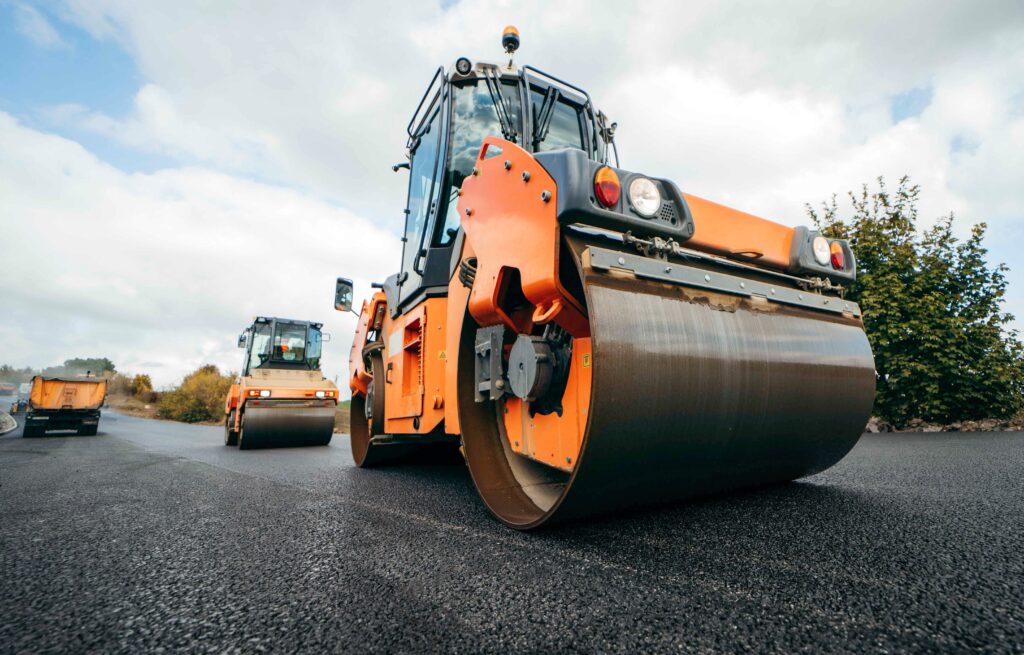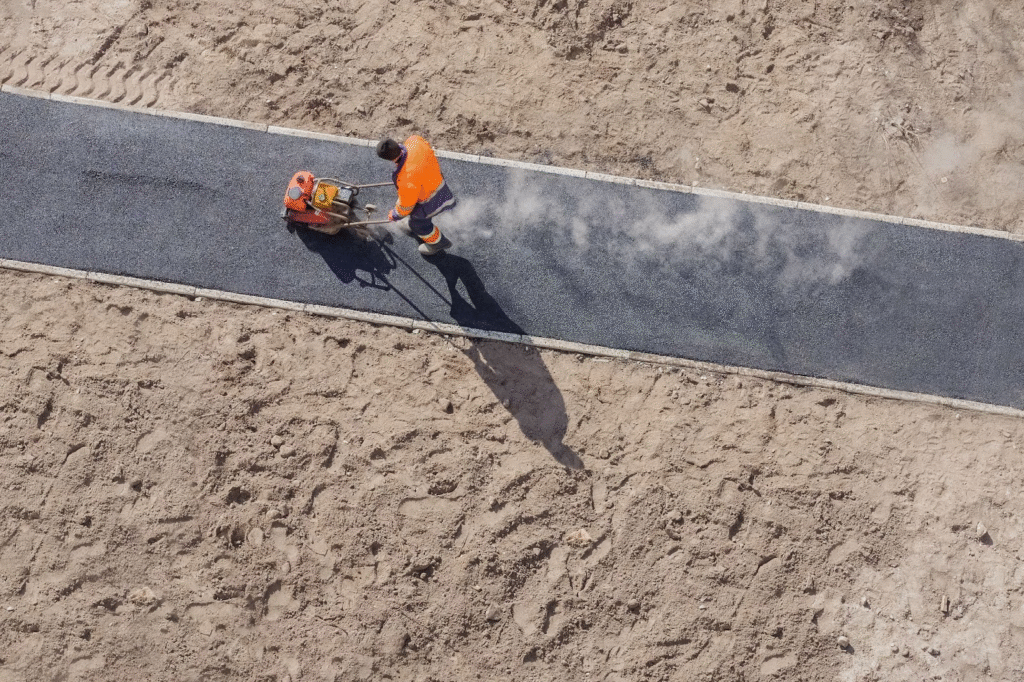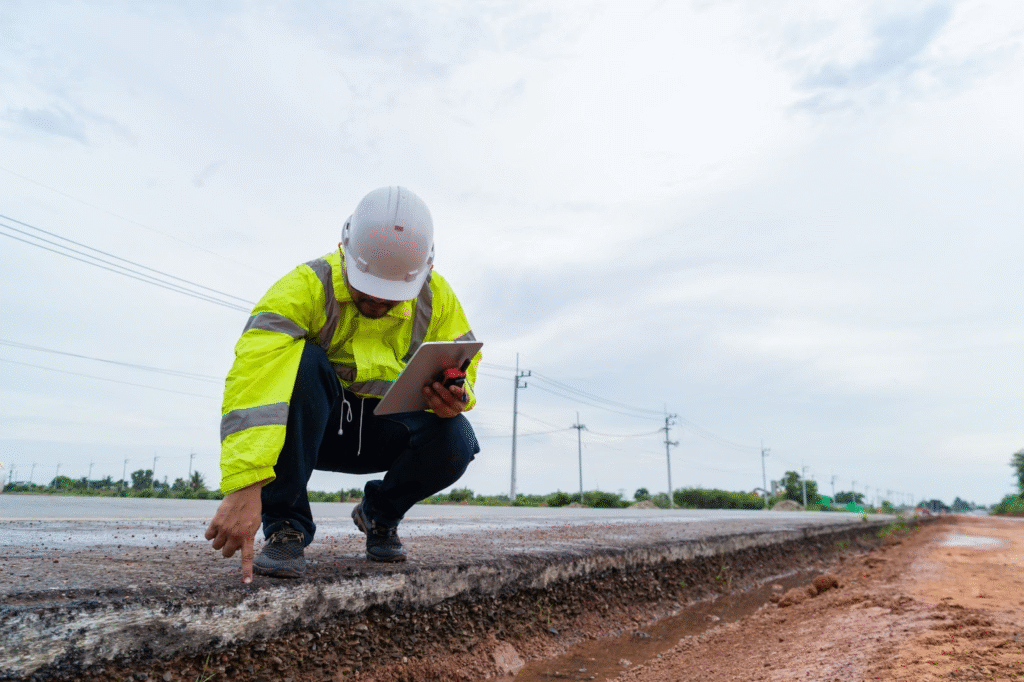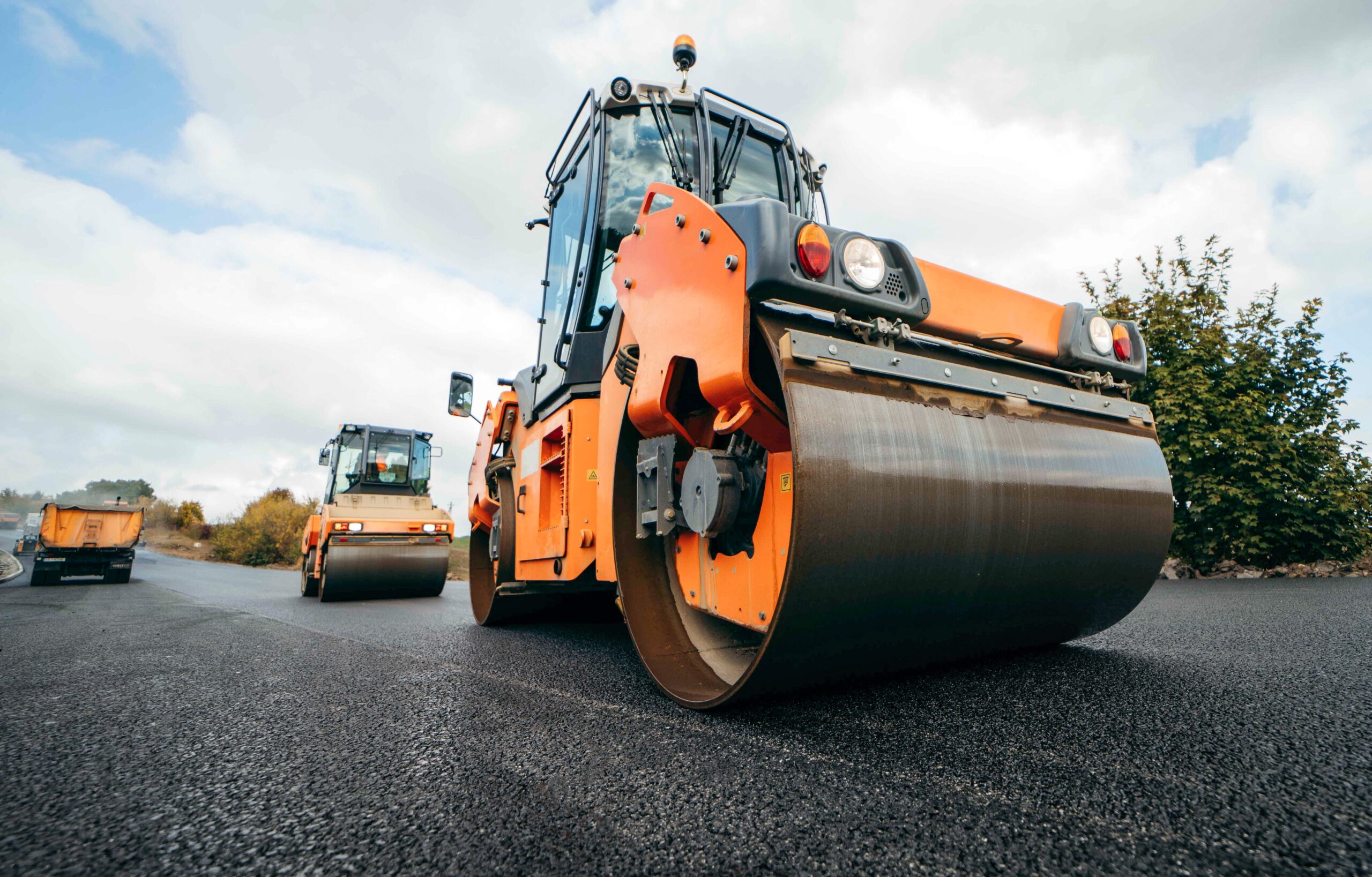Asphalt construction is the process of building paved surfaces, such as roads, parking lots, driveways, airport runways, and pathways, using asphalt, which is a mixture of aggregates (like crushed stone, sand, or gravel) bound together with bitumen (a sticky, petroleum-based material). Constructing new asphalt surfaces from scratch is the cornerstone of building strong and reliable infrastructure.
It involves expertly placing and compacting layers of aggregate mixed with bitumen to deliver smooth, long-lasting surfaces that can withstand heavy loads and weather extremes. Over 94 percent of paved roads in the U.S. are surfaced with asphalt, underscoring its dominance in roadway construction.

For those looking to build durable surfaces, new construction paving services offer the expertise needed to ensure a solid foundation and lasting performance. This method’s cost efficiency and performance make it the go-to choice for residential, commercial, and municipal projects alike. With rapid urban growth and extensive infrastructure spending driving demand, the global asphalt market is projected to grow at a 4.4 percent CAGR through 2033, signaling sustained expansion in construction needs.
This guide aims to help you navigate everything, from best practices to material choices, so you can lay a foundation that lasts.
What is New Asphalt Construction?
New asphalt construction refers to the complete installation of fresh asphalt pavement on a prepared base, typically involving building a new surface from the ground up. Unlike resurfacing or repair work, which focuses on fixing or renewing an existing asphalt layer, new asphalt construction starts with a base that is either newly laid or completely rebuilt.

Typical applications of new asphalt construction include building new roads, parking lots, driveways, airport runways, and commercial or municipal paved areas. These projects demand precise engineering and materials to withstand heavy traffic loads and environmental stress. For businesses and organizations looking for high-quality paving solutions, commercial asphalt paving services are crucial to ensure durability and long-lasting performance.
Understanding the fundamentals of new asphalt construction is essential, but equally important is knowing the step-by-step process that ensures a durable, high-quality pavement.
Benefits of New Asphalt Construction
Some benefits of new asphalt construction are:
- Durability: New asphalt offers a strong, flexible surface that resists cracking and potholes. According to a document from the Illinois Asphalt Pavement Association, properly maintained asphalt can last 20 years or more.
- Cost-Effectiveness: Asphalt usually costs less upfront than concrete and saves 30% to 50% on life-cycle costs over time.
- Quick Installation: Asphalt cures rapidly, allowing surfaces to be ready for traffic within hours or days, minimizing downtime and disruptions.
Key Considerations Before Starting New Asphalt Construction
Before beginning any new asphalt construction project, careful planning and evaluation are essential to ensure a durable, cost-effective, and long-lasting pavement. Factors such as site conditions, climate, asphalt mix selection, and budgeting significantly influence the success of the project.
Understanding these key considerations helps property owners and contractors make informed decisions and avoid costly mistakes.
Assessing the Site for New Asphalt Construction
Evaluate the site for traffic flow, drainage efficiency, and soil stability to determine its suitability for asphalt paving. Use a checklist to identify potential issues such as poor drainage or unstable soil, which could undermine the pavement’s durability.
Climate and Weather Considerations
Weather conditions directly impact asphalt installation. Warm, dry weather is ideal for proper curing and compaction, while cold or wet climates can delay construction and reduce pavement quality. Selecting the right time of year helps optimize results.
Choosing the Right Asphalt Mix
Select from hot mix, warm mix, or cold mix asphalt based on project requirements, traffic intensity, and environmental conditions. The right mix improves performance, longevity, and environmental sustainability.
Budgeting and Cost Factors
Understand the costs of materials, labor, and equipment needed for new asphalt construction. Compare asphalt construction costs to other materials like concrete to plan your budget effectively and choose the best value option.
The Asphalt Construction Process: Step-by-Step

Understanding the asphalt construction process is crucial for ensuring a high-quality, long-lasting paved surface. From initial excavation to the final finishing touches, each step must be carefully executed to achieve optimal durability and performance.
Step 1: Site Excavation and Preparation
The first step involves removing any existing pavement or debris and excavating the site to the required depth. Proper leveling and grading are critical to promote effective drainage and prevent water pooling, which can damage the pavement over time. Preparing a clean, stable surface sets the foundation for all subsequent layers.
Step 2: Installing the Base Layer
A strong base layer is essential for supporting the asphalt surface and preventing future cracking or settling. Typically, materials like crushed stone or gravel are spread and compacted to form a stable foundation that evenly distributes traffic loads and enhances drainage beneath the asphalt.
Step 3: Laying the Asphalt Layer
Next, the hot asphalt mix is delivered and laid evenly over the prepared base layer. Precision is important to ensure the asphalt thickness meets project specifications, which affects the pavement’s ability to withstand traffic stress and weather conditions.
Step 4: Compaction and Finishing
Once laid, the asphalt is compacted using heavy rollers to remove air pockets and create a smooth, dense surface. This compaction step ensures structural integrity and prolongs the pavement’s lifespan. Finally, finishing touches include edge trimming and ensuring proper drainage protects your asphalt and provides lasting performance.
Each stage plays a vital role in creating a durable pavement that resists cracking, rutting, and other common failures, ultimately extending the surface’s useful life.
Common Challenges in New Asphalt Construction

New asphalt construction projects often face various challenges that can impact timelines, costs, and overall quality. Being aware of these potential issues helps property owners and contractors plan proactively to minimize risks and ensure a smoother project.
1. Weather Delays and Impact
Adverse weather conditions like rain, extreme cold, or high humidity can delay asphalt laying and curing. Moisture prevents proper bonding of the asphalt mix, while cold temperatures can affect compaction quality. Contractors often monitor weather forecasts closely and may reschedule work or use special materials to mitigate these risks.
2. Budget Overruns and Unforeseen Costs
Unexpected site conditions such as buried debris, unstable soil, or equipment breakdowns can lead to additional expenses and extend project timelines. Proper site inspections and contingency planning are crucial to managing these unforeseen costs and avoiding budget overruns.
3. Site Preparation Issues
Challenges like poor soil stability or inadequate drainage can compromise the foundation of the asphalt surface. Resolving these issues may require soil stabilization techniques, improved grading, or installation of drainage systems to ensure a durable, long-lasting pavement.
Environmental Considerations in New Asphalt Construction
New asphalt construction can be designed with sustainability in mind by incorporating recycled materials and eco-friendly processes. By reducing waste and lowering energy consumption, the asphalt industry is making significant strides toward greener paving solutions.
These efforts not only benefit the environment but can also offer cost savings and improved performance.
Recycling Asphalt and Reducing Waste
Old asphalt pavement is often milled and recycled for use in new paving projects, significantly reducing waste sent to landfills. According to the famous website The Conversation, over 95% of asphalt pavement is recycled in the United States, making it one of the most recycled materials nationwide. Using Reclaimed Asphalt Pavement (RAP) conserves natural resources and lowers the environmental impact of new construction.
Reducing Carbon Footprint in Asphalt Construction
The industry is adopting greener technologies like warm-mix asphalt, which requires lower temperatures during production compared to traditional hot-mix asphalt. This reduces energy consumption and emissions, resulting in a smaller carbon footprint. Studies show that warm-mix asphalt can lower greenhouse gas emissions by 20-35%, supporting more sustainable paving projects.
Using Eco-Friendly Binders and Additives
Beyond recycling and temperature reduction, the use of bio-based binders and environmentally friendly additives is growing. These alternatives reduce reliance on petroleum-based products and improve the longevity of asphalt surfaces, further minimizing environmental impact over the pavement’s life cycle.
Cost of New Asphalt Construction

When planning a new asphalt construction project, understanding the cost breakdown is essential for budgeting and avoiding surprises. The overall expense depends on several factors, including materials, labor, equipment, and the complexity of the site preparation.
Knowing what to expect helps property owners and contractors make informed decisions and choose options that balance quality and budget.
Estimating the Cost of New Asphalt Construction
Estimating costs starts with looking at the size and scope of the project. Larger areas naturally require more materials and labor, which drives up the price. Location matters, too, since labor and equipment rates vary regionally.
On average, asphalt paving can range from $3 to $7 per square foot, making it generally more affordable than alternatives like concrete, which often runs $6 to $10 per square foot. This cost difference makes asphalt a popular choice for driveways, parking lots, and roadways.
Hidden Costs to Watch Out For
While the upfront cost estimates are helpful, some expenses may not be obvious at first. For example, site preparation can reveal challenges like poor soil stability or drainage issues that require extra work and materials.
Being aware of these potential hidden costs early on helps avoid last-minute budget overruns and ensures a smoother project from start to finish.
Long-Term Benefits of New Asphalt Construction
Investing in new asphalt construction offers significant long-term advantages that go beyond just the initial installation. These benefits make asphalt a smart choice for residential, commercial, and municipal projects alike.
Longevity of Asphalt Surfaces
Well-constructed asphalt pavements can last between 15 to 20 years or more when paired with regular maintenance such as sealcoating and crack filling. According to a study, asphalt roads typically have a lifespan of around 17-20 years before needing major rehabilitation.
This extended durability helps minimize disruption and replacement costs over time, making asphalt a dependable choice for long-term infrastructure needs.
Cost Savings Over Time
While the initial investment in new asphalt construction may seem substantial, it is often outweighed by long-term savings. Asphalt’s durability reduces the frequency of repairs and maintenance compared to other paving materials.
Lower maintenance costs, combined with the speed and cost-effectiveness of repairs, contribute to better overall value. These savings help property owners avoid unexpected expenses and maximize their return on investment.
How to Maintain Newly Installed Asphalt

Proper maintenance is essential to maximize the lifespan and performance of new asphalt surfaces. By following a few key practices, property owners can protect their investment and keep their pavement looking and functioning its best for years to come.
Regular Inspections and Sealing
Conducting regular inspections helps catch small cracks, surface wear, or drainage issues early, preventing costly damage down the road. Commercial sealcoating is a crucial maintenance step; it acts as a protective barrier against UV rays, water penetration, and chemical spills, which can degrade asphalt.
Experts recommend applying a sealcoat every 2 to 3 years, depending on traffic and weather conditions, to increase the lifespan.
Avoiding Common Asphalt Problems
To avoid typical asphalt issues such as cracking, rutting, and fading, keep in mind these key practices:
- Ensure proper drainage to prevent water pooling on the surface.
- Limit exposure to heavy loads and avoid sharp turns that stress the pavement.
- Repair minor cracks and damage promptly before they worsen.
- Keep vehicles off the asphalt during extreme heat or cold to reduce surface deformation.
Frequently Asked Questions
Ready for Durable Asphalt? Contact Us
New asphalt construction offers a durable, cost-effective solution for creating long-lasting roads, driveways, and parking lots. By understanding the process, from site assessment to proper maintenance, you can ensure a high-quality paved surface that stands the test of time. Investing in professional installation and regular upkeep not only enhances durability but also saves money on costly repairs in the long run.
If you’re ready to start your new asphalt project or want expert advice tailored to your needs, don’t hesitate to reach out. Contact us today at Asphalt Coatings Company for a consultation, site assessment, or personalized estimate. Let’s build a smoother, stronger surface together!




